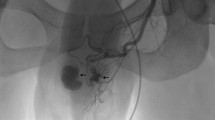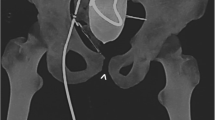Abstract
High-flow or arterial priapism is an uncommon condition resulting from perineal or penile trauma. The classical features are a painless erection of the cavernous bodies while the corpus spongiosum stays flaccid. This case highlights a 11-year-old boy who presented with painless semi rigid erection of 3 days duration following a blunt skateboard injury to his perineum. Following failed conservative treatment, the patient underwent bilateral internal pudendal angiography with localization and embolization. Follow up in 1 month showed patient to have normal nocturnal and reflexogenic erections. Medical and surgical treatments for high-flow priapism have been described in literature with varying degree of success and complications. The current accepted standard of care is pelvic angiography and super-selective embolization of internal pudendal artery.



Similar content being viewed by others
References
Burt FB, Schirmer HK, Scott WW (1960) A new concept in management of priapism. J Urol 83:60
Volkmer BG, Nesslauer T, Kraemer SC et al (2001) Prepubertal high flow priapism: incidence, diagnosis and treatment. J Urol 166:1018
Hatzichristou D, Salpigiggidis G, Hatzimouratidis K et al (2002) Management strategy for arterial priapism: therapeutic dilemmas. J Urol 168:2074
Goto T, Yagi S, Matsushita S et al (1999) Diagnosis and treatment of priapism: experience with 5 cases. Urology 53:1019
Walker TG, Grant PW, Goldstein I, Krane RJ, Greenfield AJ (1990) “High flow” priapism treatmentwith superselective transcatheter embolization. Radiology 174:1053
Pautler SE, Brock GB (2001) Priapism. Urol Clin North Am 28:391
Kim N, Vardi Y, Padma-Nathan H et al (1993) Oxygen tension regulates the nitric oxide pathway: physiological role in penile erection. J Clin Invest 91:437
Witt MA, Goldstein I, Saenz de Tejada I et al (1990) Traumatic laceration of intracavernosal arteries: the pathophysiology of non-ischemic, high flow, arterial priapism. J Urol 143:129
Bertolotto M, Quaia E, Mucelli FP et al (2003) Color Doppler imaging of posttraumatic priapism before and after selective embolization. Radiographics 23:495
Savoca G, Pietropaolo F, Scieri F et al (2004) Sexual function after highly selective embolization of cavernous artery in patients with high flow priapism: long term follow up. J Urol 172:644
Ciampalini S, Savoca G, Buttazzi L et al (2002) High flow priapism: treatment and long term follow-up. Urology 59:110
Hakim LS, Kulaksizoglu H, Mulligan H et al (1996) Evolving concepts in the diagnosis and treatment of arterial high flow priapism. J Urol 155:541
Author information
Authors and Affiliations
Corresponding author
Rights and permissions
About this article
Cite this article
Chung, E., McKnight, J. & Hosken, B. Post traumatic prepubertal high-flow priapism: a rare occurrence. Pediatr Surg Int 24, 379–381 (2008). https://doi.org/10.1007/s00383-007-1936-4
Accepted:
Published:
Issue Date:
DOI: https://doi.org/10.1007/s00383-007-1936-4




